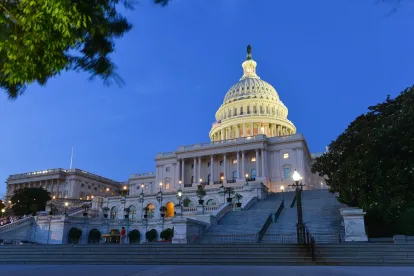Recent news that the Democrats flipped both U.S. Senate seats in Georgia’s run-off election means that the Democrats have enough votes to add the Congressional Review Act (CRA)[1] to the tools that could be used to advance President-elect Joe Biden’s regulatory agenda through the repeal of recent Trump administrative actions. The CRA is a desirable tool because it can reverse actions of the prior administration without the time and resources necessary to do so through traditional rulemaking.
But what considerations might Congress and the Biden administration face in deciding whether to employ this tool? And what environment and natural resources actions might be targets for the CRA as a result? This blog post breaks everything down.
How the CRA Works
The CRA provides Congress with a period in which it can act quickly to invalidate “rules.” This term is broadly defined—with some exceptions—such that the CRA may be used to disapprove not only regulations produced through notice-and-comment rulemaking but potentially also other agency policies or guidance.[2] In simplest terms, the statute requires federal agencies to present rules to Congress, and Congress then has 60 working days to introduce and pass a joint resolution disapproving the rule.[3] Under the CRA, passing a joint resolution of disapproval requires a mere simple majority vote in each chamber. If both chambers pass a resolution, the president may sign it into law.[4] It is this simple majority that provides Democrats, with their 50-seats plus the vote of Vice President Harris, the opportunity to employ the CRA as a tool in dismantling Trump-era regulations.
The key effects of a resolution of disapproval are two-fold. First, a disapproval resolution prevents a new rule from taking effect. Or, if the rule has already taken effect, the disapproval resolution nullifies the rule: the rule “shall be treated as though such rule had never taken effect.”[5] Second, a successful disapproval resolution prohibits the administration from issuing a rule in “substantially the same form” and from issuing a “new rule that that is substantially the same” as the disapproved rule.[6]
Key Dates Impacting the Applicability of the CRA
There are two different categories of rules that this Congress can seek to disapprove with a joint disapproval resolution. Congress can invalidate so-called “midnight rules” released at the tail end of the Trump administration in 2021 for a period of 60 days from the receipt of each rule. Additionally, for those rules that were submitted to Congress within the 60 working days of when the 116th Congress adjourned, the period in which this Congress can submit and act on a disapproval resolution restarts on the 15th day of the 117th Congress. This is known as the “lookback” period, which we estimate to begin on or around August 21, 2020.[7]
Some Considerations That Might Weigh For or Against Disapproving a Rule Through the CRA
The single biggest advantage to using the CRA to revoke some of the prior administration’s rules is that it nullifies a rule without having to go through the time- and resource-intensive process of traditional notice-and-comment rulemaking. Following the Administrative Procedure Act (APA) requires significant agency resources and could take a year or more to repeal a rule (and even longer to promulgate a replacement rule if one is desirable). In contrast, if Democrats can sustain a simple majority in both chambers, they could reverse some late Trump administration acts within a matter of weeks and allow the Biden administration to focus their resources elsewhere in advancing the regulatory agenda.
However, there are several key factors the new administration will need to consider:
-
Whether the agency action at issue meets the CRA’s definition of a “rule,” which contains three important exceptions, two of which are relevant here: (1) “any rule relating to agency management or personnel” and (2) “any rule of agency organization, procedure, or practice that does not substantially affect the rights or obligations of non-agency parties.”[8]
-
As our previous post explains, the meaning of “substantially similar” is an open question, and it is not clear whether an agency’s determination that its new rule is not “substantially similar” is subject to judicial review. Consequently, these uncertainties, and the potential to limit the agency’s discretion to act in the future, will be a key factor as Democrats consider when to use the CRA, in particular on environmental issues where the Biden administration intends to take further substantive regulatory action.
-
The CRA has been used sparingly in the past. Of the 16 times congressional republicans and the Trump administration successfully used the CRA in 2017, only three—each issued by the Department of Interior—addressed environment or natural resources issues.[9] This suggests that only rules related to the very highest priorities of congressional Democrats and the Biden administration are likely be considered.
-
The disapproval process is only available during a limited time, and Congress must pass a joint resolution of disapproval for each rule it wishes to overturn—rules cannot be combined. Thus, the administration may need to carefully consider how the use of the CRA might take congressional resources from other priorities, including confirming key Biden administration appointees and the need to address expiring COVID relief initiatives in early 2021.
-
The CRA can only be used to repeal a rule in its entirety. If the administrative agency is likely to reform only certain aspects of a rule, it will need to do so through APA rulemaking.
What Trump Administrative Actions Might Be the Target of a CRA Joint Resolution of Disapproval?
We anticipate congressional Democrats and the Biden administration to give serious consideration to using the CRA to repeal one or more of the following actions. These actions were either issued in 2021 or fall within our estimated “lookback” period (beginning August 21, 2020).
-
EPA’s Significant Contribution Finding for Greenhouse Gas Emissions (GHGs) from New, Modified, and Reconstructed Stationary Sources
This rule was a bit of a surprise to most stakeholders, who were waiting for EPA to finalize its rule amending the Obama administration’s 2015 power sector GHG New Source Performance Standards (NSPS). Instead, EPA issued a rule establishing a threshold for purposes of regulating GHGs from stationary sources under Clean Air Act 111(b).[10] EPA set the threshold at 3%, meaning that only source categories that exceed 3% of U.S. GHG emissions can be regulated going forward. Applying this standard, EPA concluded that electric generating units exceed the threshold, but source categories—such as oil and gas production and processing; refineries; and industrial, commercial, and institutional boilers—currently do not.
Because of its implications for regulating GHG emissions, this is likely to be a prime target for Congress and/or the Biden administration to roll back. The risk also seems to be low that future action(s) by the Biden EPA might be considered “substantially similar” in that there are range of options available to EPA if it is inclined to take issue future regulations. These may include issuing a rule setting an entirely different significance threshold or multiple rules setting different thresholds on an industry-by-industry basis.
Date Received by House: TBD | Date Received by Senate: TBD |Date Published in Federal Register: January 13, 2021| Effective Date: March 15, 2021
-
EPA’s Regulatory Science Transparency Rule
This rule requires EPA, when promulgating significant regulations across the agency that are driven by the quantitative relationship between the amount of dose or exposure to a pollutant or contaminant, to give greater weight to scientific studies for which the underlying data is publicly available. And, it requires EPA to identify and make publicly available the science that serves as the basis for informing any significant regulation going forward.
Although EPA has stated that this rule is not subject to the CRA because it falls under the exception for rules of “agency organization, procedure or practice” that do not “substantially affect the rights or obligations of non-agency parties,”[11] and it has been suggested that this rule cannot be subject to the CRA because it is not economically significant, these arguments may not deter Congress from acting. The CRA prohibits judicial review of any “determination, finding, action, or omission under” the statute,[12] which the majority of courts have interpreted to bar judicial review of congressional actions under the CRA.[13] In other words, it may be Congress that gets the last word on whether an agency action meets the definition of “rule” or falls under one of the exceptions in the statute. Additionally, even when an agency fails to submit a “rule” to Congress, Congress can use the CRA by obtaining from the Government Accountability Office a determination of whether an action is a “rule” under the CRA and then publishing the GAO opinion in the Congressional Record to start the 60-day clock.[14] Finally, the CRA’s disapproval provisions apply to “rules”—not the narrower subset of “major rules” that are economically significant.[15]
Date Received by House: TBD | Date Received by Senate: TBD |Date Published in Federal Register: January 6, 2021 | Effective Date: January 6, 2021
-
U.S. Fish & Wildlife Service’s Regulations Governing Take of Migratory Birds
This rule defines the scope of the Migratory Bird Treaty Act (MBTA)[16] and determines that the MBTA does not prohibit and criminalize the accidental or “incidental” take or killing of migratory birds. The rule codifies an earlier Trump administration policy that itself reversed the Obama administration’s efforts to formalize a contrary but longstanding interpretation of the statute.
This rule has drawn criticism of a number of environmental nongovernmental organizations. Whether or not Congress acts on this rule, look for the Biden administration to take action to return to the prior interpretation and, potentially, to embark on a rulemaking to codify that interpretation and create a permit program.
Date Received by House: TBD | Date Received by Senate: TBD | Date Published in Federal Register: January 7, 2021 | Effective Date: February 8, 2021
-
EPA’s Clean Air Act Benefit-Cost Analysis Rule
This procedural rule is intended to ensure consistency in the way EPA calculates costs and benefits of significant regulations promulgated under the Clean Air Act. Among other things, the rule requires EPA to prepare a benefit-cost analysis for all future significant Clean Air Act regulations and to be transparent about which social benefits are attributable to the specific pollution reductions or other environmental quality goals targeted by the statutory provisions under which the rule is issued.
This rule has also attracted criticism, perhaps unfairly so as it does not actually limit EPA’s discretion to consider so-called “co-benefits”—reduced emissions of pollutants not targeted by the rule.[17] Nevertheless, it may be a target for congressional disapproval due to its unpopularity.
Date Received by House: TBD | Date Received by Senate: TBD | Date Published in Federal Register: December 23, 2020 | Effective Date: December 23, 2020
-
EPA’s Oil & Natural Gas Sector Methane “Policy Rule”
One of a pair of rules EPA issued to roll back the Obama administration’s 2016 New Source Performance Standards controlling methane emissions, the so-called “Policy Rule” removes the transmission and storage segment of the oil and gas industry from regulation and rescind the prior administration’s regulations for that sector. And, it rescinds the performance standards for methane that were part of the Obama administration’s 2016 rule in favor of controlling these emissions by achieving reductions in volatile organic compounds. Because the Policy Rule restricts EPA’s ability to reduce methane emissions from the oil and natural gas sector, it may be a high priority for some rollback effort.
Date Received by House: September 14, 2020 | Date Received by Senate: September 16, 2020 | Date Published in Federal Register: September 14, 2020 | Effective Date: September 14, 2020
-
EPA’s Major Source to Area Source (MM2A) Rule
This rule amended the general provisions that apply to National Emission Standards for Hazardous Air Pollutants (NESHAP) issued under the Clean Air Act so that a “major source” of hazardous air pollutants (HAPs) can be reclassified to an “area source” if the source reduces its potential to admit HAPs below the relevant thresholds. The rule codifies the Trump administration’s 2018 rescission of a 1995 EPA memorandum known commonly as the “Once In, Always In” policy in an attempt to make it more difficult for a future administration to reinstate the 1995 policy. As a result, it may be a high priority for the incoming administration to rollback (although EPA would also need to take some action to reissue the prior policy).
Date Received by House: December 28, 2020 | Date Received by Senate: October 8, 2020 |Date Published in Federal Register: November 19, 2020 | Effective Date: January 19, 2021
Some Recent High Profile Actions May Be a Poor Fit for the CRA
-
BLM’s Arctic National Wildlife Refuge (ANWR) Oil and Gas Leasing Program
Although the controversial nature of BLM’s ANWR leasing program issued may counsel in favor of using the CRA to nullify it, there may be several reasons why this action may be ill-fitted to the CRA process. First, Congress required area-wide leasing sales within the Coastal Plain Oil and Gas Program area as part of the Tax Cuts and Jobs Act of 2017. The statute requires BLM to conduct at least two such sales, one by December 22, 2021 and one by December 22, 2024. As a result, the Biden administration’s discretion to enact a different program probably may lie only in determining precisely where leasing would be conducted and under what terms and conditions—but not to cancel leasing all together—raising questions whether a new lease is “substantially similar” to the prior lease. This also begs the question of whether Congress could use the CRA to repeal its prior direction to conduct the leasing sales. However, the statute stipulates that the resolving clause of any joint resolution of disapproval must state “‘That Congress disapproves the rule submitted by the ____ relating to ____, and such rule shall have no force or effect.’ (The blank spaces being appropriately filled in).”[18] This suggests that, if Congress’s intent is to separate repeal the underlying legislative trigger for BLM’s leasing program, an explicit action doing so may be required.[19]
Second, one of the two lease sales already occurred January 6, 2021 and attracted far less interest than BLM anticipated.[20]
Lastly, there are timing and procedural concerns. The leasing program decision was announced on August 17, 2020 (putting it outside the “lookback” period). Although a notice of the availability of the decision was published in the Federal Register on August 21, it is not clear that the decision itself has been submitted to Congress. Although an agency’s failure to do so does not bar disapproval under the CRA, it adds extra steps to the process.[21]
Date Notice of Decision Published in Federal Register: August 21, 2020 | Effective Date: August 17, 2020
-
Army Corps’ Reissuance and Modification of Some of the CWA Section 404 Nationwide Permits
On January 13, 2021, the Federal Register published the Corps’ final rule issuing or re-issuing 16 Nationwide Permits (NWPs) that authorize certain activities under Section 404 of the Clean Water Act. These 16 NWPs are a sub-set of the more than 4 dozen NWPs. Among other things, the rule divides NWP 12 (which authorizes utility line activities) into three separate NWPs: NWP 12 (oil or natural gas pipeline activities); NWP 57 (electric utility line and telecommunications activities); and NWP 58 (utility line activities for water and other substances).
Although we expect this rule to be controversial because opponents of oil and gas pipelines have mounted legal challenges to NWP 12, the rule is unlikely to be the target of a CRA resolution because it issues or reissues NWPs that authorize a range of other actions under a widely used permit program and these other NWPs would be nullified if a CRA resolution were passed disapproving the rule.
Date Received by House: TBD | Date Received by Senate: TBD |Date Published in Federal Register: January 13, 2021 | Effective Date: March 15, 2021
-
EPA’s Draft Guidance Applying the Supreme Court’s County of Maui Decision
EPA’s draft memorandum provides guidance to permitting authorities and the regulated community on implementing the Supreme Court’s decision in County of Maui v. Hawaii Wildlife Fund[22] on a case-by-case basis. The Court’s 2020 decision outlined a number of non-exclusive factors for evaluating whether a discharge of a pollutant from a point source that travels through groundwater to a water of the United States is the “functional equivalent” of a direct discharge from a point source to a water of the United States.
Although EPA’s memorandum certainly attracted the attention of both the regulated community and various non-governmental organizations, as it is merely a guidance document in draft form, it would not take an act of Congress for the Biden administration to revoke. This document also raises unresolved issues about the scope of Congress’s disapproval authority and the scope of judicial review under the CRA.
Date Received by House: TBD | Date Received by Senate: TBD | Notice of the Guidance Published in the Federal Register January 21, 2021)
A Number of Other Recent Agency Actions Appear to Fall Within the Lookback Period:
-
EPA’s Approval of Texas’s Application for Partial National Pollutant Discharge Elimination System Authorization for Oil and Gas Discharges (approved and effective January 15, 2021)
-
U.S. FWS’s Recent Endangered Species Act Regulations Regarding Designating Critical Habitat and Listing Endangered and Threatened Species (published in the Federal Register December 18, 2020 and December 16, 2020, respectively)
-
EPA’s Steam Electric Reconsideration Rule that revises the effluent limitation guidelines and standards for electric generating units (published in the Federal Register October 13, 2020)
-
EPA’s Regulations Governing the Disposal of Coal Combustion Residuals from Electric Utilities (published in the Federal Register August 28, 2020)
-
EPA’s Rule Project Emissions Accounting for Nonattainment New Source Review (published in the Federal Register November 24, 2020)
Other High-Profile Agency Actions May Be Ineligible for CRA Disapproval Because They Were Promulgated Before the Start of the Lookback Period[23]
-
PHMSA’s Regulations for Liquefied Natural Gas (LNG) Transported by Rail (published in the Federal Register July 24, 2020)
-
CEQ’s National Environmental Policy Act (NEPA) Implementing Regulations (published in the Federal Register July 16, 2020)
-
EPA’s Clean Water Act Section 401 Certification Rule (published in the Federal Register July 13, 2020)
-
EPA’s and NHTSA’s Safer Affordable Fuel-Efficient Vehicles Rule (published in the Federal Register April 30, 2020)
-
EPA’s Navigable Waters Protection Rule Defining “Waters of the United States” (published in the Federal Register April 21, 2020)
Conclusion
Although the disapproval mechanism of the Congressional Review Act can be an efficient and important tool for Congress to repudiate recent actions of the outgoing administration, each chamber of Congress will need to weigh numerous considerations, including competing demands for congressional resources to confirm Biden administration appointees, conduct the second impeachment trial of President Trump, and advance other key aspects of the administration’s agenda—including further economic stimulus to alleviate the effects of the Covid-19 pandemic. Ultimately it is likely that only a handful (at most) of the CRA resolutions Congress may consider will target environment or natural resources regulations.
[1] 5 U.S.C. §§ 801-808. Additionally, the Biden administration intends to issue a memo on January 20, 2021 that halts all last-minute Trump administration regulations that have not yet taken effect. See Trevor Hunnicutt, Reuters, Biden to act quickly to roll back harmful ‘midnight regulations’—transition (Dec. 3, 2020), https://www.reuters.com/article/us-usa-biden-transition/biden-to-act-quickly-to-roll-back-harmful-midnight-regulations-transition-idUSKBN29422E.
[2] 5 U.S.C. §§ 551(4), 804(3).
[3] Practically speaking, a rule is considered to have been “received by Congress” on the later of its receipt in the Office of the Speaker of the House, its referral to Senate committee, or its publication in the Federal Register.
[4] For more information on the congressional procedures used under the CRA (including the “fast track” provisions available to the U.S. Senate), see U.S. Congressional Research Service, The Congressional Review Act (CRA): Frequently Asked Questions (R43992; Jan. 14, 2020), https://crsreports.congress.gov/product/pdf/R/R43992.
[5] 5 U.S.C. § 801(b)(1), (f).
[6] See 5 U.S.C. § 801(b)(2).
[7] The House and Senate Parliamentarians will ultimately issue a formal determination as to the precise date. See Congressional Review Act and the 2020 Election by Bracewell’s Policy Resolution Group for more detail on calculating the lookback period.
[8] 5 U.S.C. § 804(3)(B)-(C).
[9] CRS Report R43992, App’x A. A fourth resolution targeting a Bureau of Land Management rule, H.J. Res. 36, failed to pass the senate. See Regulatory Studies Center, George Washington University, Congressional Review Act, https://regulatorystudies.columbian.gwu.edu/congressional-review-act (last visited Jan. 19, 2021).
[10] EPA deferred action on its proposal to revise the NSPS itself—including changing the definition of “best system of emissions reductions” (which the Obama administration defined to mean partial carbon capture and sequestration)—to a separate future action. 86 Fed. Reg. 2542, 2544 (Jan. 13, 2021).
[11] 86 Fed. Reg. 469, 491 (Jan. 6, 2021).
[12] 5 U.S.C. § 805.
[13] CRS Report R43992 at 20-21.
[14] CRS Report R43992 at 12.
[15] 5 U.S.C. §§ 801(b), 802.
[16] 16 U.S.C. § 703.
[17] EPA has also stated that it believes the rule to be exempt from the CRA, 85 Fed. Reg. 8413, 84154 (Dec. 23, 2020), and is therefore unlikely to submit the rule to Congress. However, for the reasons explained above, EPA’s view may not be dispositive.
[18] 5 U.S.C. § 802(a).
[19] In contrast, a successful CRA disapproval resolution can actually provide the agency more time to act on a future rule. If an agency is under a statutory, regulatory, or court-imposed deadline to promulgate a rule, a successful CRA resolution extends that deadline to one year from the enactment of the joint resolution. 5 U.S.C. § 803.
[20] In fact, the government sold only half of the 22 tracts it offered for sale and none of Alaska’s three top oil producers submitted bids. Alex DeMarban, ANWR lease sale fizzles for Trump administration, with revenue falling far short of hopes, Anchorage Daily News (updated Jan. 7, 2021), https://www.adn.com/business-economy/energy/2021/01/06/anwr-lease-sale-brings-in-144-million-in-bids-mostly-from-alaska-state-owned-corporation/.
[21] See footnote 15 and accompanying text above.
[22] 140 S. Ct. 1462 (2020).
[23] EPA also finalized the Affordable Clean Energy Rule to repeal and replace the Clean Power Plan prior to the start of the lookback period. However, the D.C. Circuit vacated and remanded the rule to EPA on January 19, 2021.





 />i
/>i

